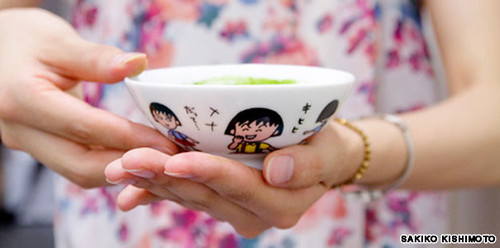news
Our aritcle on CNN online/CNNオンラインに掲載されました
現在もお読みいただけます。英語ですが、どうぞお楽しみくださいで候~
By Donald Eubank 10 September, 2010
The Japanese tea ceremony has long been thought of as an outdated remnant of cultural history fit only for tourists in stuffy locales and costing a premium.
But one young promoter is bringing the tea ceremony up to date, making it affordable for even the most penny-pinching salarymen and office ladies.
"Sen Rikyu -- the 16th century master of the Japanese 'Way of tea' -- liked the dishes that common people such as fishermen and farmers used," tea ceremony promoter Nozomi Tanida says, pulling out a child's cup decorated with the popular anime character Chibi Maruko-chan.
"He liked chipped, uneven cups that only served their purpose, not the kinds of museum pieces from Korea and China that the powerful daimyo (landowners) of his time, Nobunaga Oda and Toyotomi Hideyoshi, flaunted."
Tanida is the creator of the web site "Tea ceremony in office. The most modern Rique-ism," (茶道をOLに開放せよ! きみも今日から千利休) with which she is trying to spread the message that everyone, especially your average salaryman and office lady, can enjoy the meditative pleasures of the ancient ritual.
To that end, today she is doing a photo session with a cute OL at the office of the mobile media developer iBroadcast Inc.
Beauty above wealth
"Usually tea ceremony is practiced by wealthy people, because you have to pay a lot for lessons. So it's mostly older people who study. But Rikyu thought that the concept of Wabi Sabi was only related to beauty -- it had nothing to do with wealth," explains Tanida.
To illustrate her point, she shows off the tiny unit kitchen in the office where she will demonstrate today's ceremony, noting that "because of Rikyu's dislike of wealthy people, he built lots of small, modest tea rooms, the same size as this."
Wabi Sabi is that most Japanese of aesthetic principals, an idea that celebrates the imperfect and transient and is characterized by simplicity, asymmetry and a closeness to nature.
While it would be difficult to describe the kitchen as having any of those more complex values, it is nothing if not simple. In reality, it's starkly utilitarian.
But as Tanida says, what she is trying to show is that office workers can "take a mental break anywhere, it doesn't have to be fancy."
A masculine form of tea ceremony
Tanida isn't the only one trying to refresh interest in tea ceremony. The 400-year-old Urasenke School presents traditional versions of the ceremony in 36 countries around the world.
The blog Japan Two reports that Shuntaro Kondo, an Urasenke tea master, has established the Avant-Garde Cha Kai, teaching the ceremony in the very casual surroundings of a standard Japanese apartment.
Waseda and Tokyo Kasei University lecturer Katsuo Naito, who studies the Edo Senke tea ceremony, is giving lessons that include historical background alongside Wakako Tezen, who follows the traditions of Matsudaira Harusato, an 18th-century daimyo from her home town in Shimane Prefecture who crafted a more masculine, samurai-like form of the practice.
While all of these contemporary practitioners are trying to keep the ceremony relevant, Tanida's take is probably the most catchy. After Rikyu was killed by Hideyoshi, his followers came up with endless rules about how the tea ceremony was properly done.
Tanida is reaching past these stuffy restrictions to remind Japanese salarymen and OLs that they don't have to be deadly serious to achieve the tea ceremony's real purpose.
She wants them to forget precious women in kimono practicing arcane rituals -- fussy, fusty and over elegant -- and focus instead on the cool virtues of contemplation, relaxation and hospitality.
« 【茶会☆受付終了】残業中こそ夜空を見上げよう☆お月見茶会feat.日菓@京都サロンド毘沙門 (ベネフィット)
» 【終了:能・体験講座】ワビサビジネススクール「能!」と言えるビジネスマン養成コース新設 (マイルストーン)


